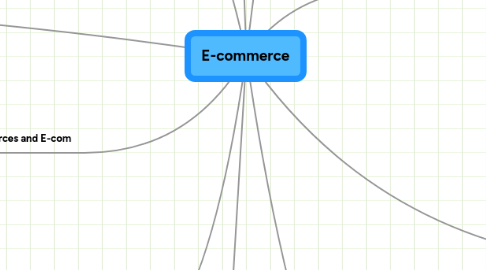
1. Internation Nature of E-com
1.1. Trust issues on the Web
1.1.1. Relying on E-com client to ensure business is being accomplished
1.2. Language Issues
1.2.1. Knowing what is expected of internation clients by means of language barriers
1.3. Cultural Issues
1.3.1. Research to build reputations will international clients can build online business
1.4. Culture and Government
1.4.1. Many different international laws may exist on an international scale
1.5. Infrastructure Issues
1.5.1. Communications in networks in which a message packet travels
2. Identifying Business Unit Opportunities
2.1. SWOT Analysis
2.1.1. Strengths
2.1.1.1. What does the co. do well? Is it strong in the market?
2.1.2. Weaknesses
2.1.2.1. What does the company do poorly? What problems could be avoided?
2.1.3. Opportunities
2.1.3.1. Do new markets exist for the companies products?
2.1.4. Threats
2.1.4.1. What is competition doing well?
3. Value Chain Management
3.1. Primary Activities
3.1.1. Identify Customers
3.1.2. Design
3.1.3. Purchase Materials and Supplies
3.1.4. Manufacture product or create service
3.1.5. Market and Sell
3.1.6. Deliver
3.2. Secondary Activities
3.2.1. Finance and Admin
3.2.2. Human Resources
3.2.3. Tech. Development
4. Economic Forces and E-com
4.1. Transaction costs
4.1.1. Total costs a buyer and seller incur as info. is gathered to negotiate a purchase-sale transaction
4.2. Markets and Hierarchies
4.2.1. Economic form of organization. Business channel where starting products goes through the chain to the retailer
4.3. Reducing transaction cost
4.3.1. By improving flow of info and increasing coordination of actions
5. Disadvantages of E-com
5.1. Newness and rapid growing pace of tech. may cause some business to be unable to keep up.
5.2. Some products are extremely hard to sell online, ie: food items
5.3. Cost to get started and to maintain tech. can be high
5.4. Many businesses can face cultural and legal barriers to conducting E-com
6. Advantages of E-com
6.1. Can help increase profits
6.2. Can increase sells and decrease costs
6.3. Well done advertising on the Web can be powerful
6.4. Used to reach small groups of clients that are geographically scattered
6.5. Increases purchasing opportunities of the buyer
6.6. Can be used to identify new suppliers and business partners
6.7. E-com increases speed and accuracy with which businesses can exchange info
6.8. Electronic payments can be easier to audit and monitor then non electronic payments, better security
7. E-com Waves
7.1. First Wave
7.1.1. E-com dominated by U.S. companies
7.1.2. Most E-com websites are in English
7.1.3. Easy access to start-up capital led to an overemphasis on creating large enterpises to exploit E-com opportunities
7.1.4. Internet technologies were slow and inexpensive
7.1.5. Bar codes and scanners were used to track inventories and production
7.2. Sceond Wave
7.2.1. Global enterprises in many countries participate in E-com
7.2.2. Websites in multiple languages
7.2.3. Rapid increase in broadband users
7.2.4. B2B E-com is increasingly integrated with radio-frequency identification
8. Development and Growth of E-com
8.1. Electronic Funds Transfers (EFTs)
8.1.1. Electronic transmissions of account exchange info over private communications networks
8.2. Electronic Data Interchange (EDI)
8.2.1. Process of one business transmitting computer- readable data in standard format to another bus.
9. Categories of E-com
9.1. Business-to-Consumer (B2C)
9.1.1. Consumer shopping on the Web
9.2. Business-to-Business (B2B)
9.2.1. Transactions conducted between businesses on Web, can also be called "E-producment"
9.3. Business Processes
9.3.1. Group of logical, related, and sequential activities in which businesses engage
9.4. Consumer-to-Consumer (C2C)
9.4.1. Individuals that buy and sell among themselves
9.5. Business-to-Gov. (B2G)
9.5.1. Business transactions with Gov. agencies

